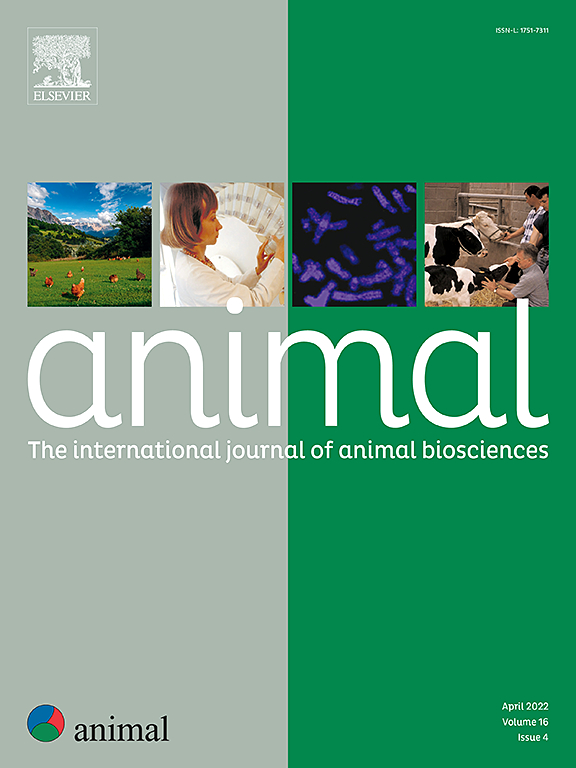间歇哺乳是一种成功的诱导多产母猪泌乳的方法。
IF 4.2
2区 农林科学
Q1 AGRICULTURE, DAIRY & ANIMAL SCIENCE
引用次数: 0
摘要
公共住房支持母猪和仔猪的自然行为,但可能增加哺乳期发情的发生率。间歇哺乳(IS)方案可以控制哺乳期卵巢活动,允许哺乳期受孕和延长哺乳期。我们假设一种新的IS方案结合迟发性IS(分娩后30天开始)和公共住房将导致最低85%的哺乳期发情率。在is方案中(平均在产后32天发病,总分离时间为8小时/天,连续7天,DIS1-DIS7),对共有饲养母猪(n = 31,胎次为1-7)的发情率、卵泡生长、受胎、背膘厚度、激素平衡(孕酮、催乳素)和仔猪平均日增重(ADG)进行监测,直至9周断奶。DIS1-DIS7母猪的常备发情率为87.1%,多产母猪(95.8%)超过初产母猪(57.1%)。DIS5的卵泡生长与DIS1的母猪背膘增加有关(P = 0.017),但受较大的哺乳窝的影响(P = 0.014)。人工授精的受精率为81.5%,总产仔数为15.6,总产仔数与母猪背膘呈显著正相关(P = 0.026)。受孕与is前泌乳时间延长(P = 0.013)、is前和is后仔猪日增重增加(P = IS1 - DIS5 (P = 0.001))有关。我们的研究假设得到了满足,表明在使用is方案的公共饲养母猪中诱导可育的哺乳期发情的可能性很高,预计多胎和更长时间的泌乳前会有好处。在妊娠后哺乳期间,在仔猪日增重较高的母猪中实现更好的母猪背膘保存,这表明IS方案和共用猪舍对仔猪蠕变采食量有有益影响。is -方案可以改善公共饲养的哺乳母猪的发情同步,从而促进哺乳期间的受孕和发情与断奶的分离。孕后哺乳及其对妊娠的影响有待进一步研究。本文章由计算机程序翻译,如有差异,请以英文原文为准。
Intermittent suckling is a successful method to induce lactational oestrus in multiparous communally housed sows
Communal housing supports the natural behaviour of sows and piglets but may increase the incidence of lactational oestrus. Lactational ovarian activity can be controlled with intermittent suckling (IS) protocols that allow lactational conception and prolonged lactation. We hypothesised that a novel IS-protocol combining late-onset of IS (initiated after 30 days postfarrowing) with communal housing would result in a minimum lactational oestrus rate of 85%. Oestrus rate, follicular growth, conception, backfat thickness, hormonal balance (progesterone, prolactin) and piglet average daily gain (ADG) in communally housed sows (n = 31, parities 1–7) were monitored during an IS-protocol (onset at median 32 d postpartum, total separation 8 h/day for 7 days, DIS1–DIS7), and until weaning at 9 weeks. Standing oestrus rate within DIS1–DIS7 was 87.1%, with multiparous (95.8%) surpassing primiparous (57.1%) sows. Follicle growth by DIS5 was linked with greater sow backfat on DIS1 (P = 0.017) but hindered by larger nursing litters (P = 0.014). Insemination resulted in 81.5% conception rate and 15.6 total born, the latter correlating positively with sow backfat at DIS1 (P = 0.026). Conception was related to longer lactation pre-IS (P = 0.013), greater piglet ADG pre- and post-IS (P < 0.01) and better sow backfat preservation post-IS (P = 0.011). Shorter lactation pre-IS resulted in a smaller increase in prolactin between DIS1 − DIS5 (P = 0.001). Our study hypothesis was met, indicating that the likelihood of inducing a fertile lactational oestrus in communally housed sows with IS-protocols is high, with benefits expected from multiparity and longer preceding lactation. Achieving to combine better sow backfat preservation in sows with higher piglet ADG during postconceptional lactation suggested a beneficial effect from the IS protocol and communal housing on piglet creep feed intake. IS-protocols can improve the synchronisation of oestrus in communally housed lactating sows, thereby facilitating conception during lactation and separation of oestrus from weaning. Postconceptional lactation and the related effects on pregnancy require further research.
求助全文
通过发布文献求助,成功后即可免费获取论文全文。
去求助
来源期刊

Animal
农林科学-奶制品与动物科学
CiteScore
7.50
自引率
2.80%
发文量
246
审稿时长
3 months
期刊介绍:
Editorial board
animal attracts the best research in animal biology and animal systems from across the spectrum of the agricultural, biomedical, and environmental sciences. It is the central element in an exciting collaboration between the British Society of Animal Science (BSAS), Institut National de la Recherche Agronomique (INRA) and the European Federation of Animal Science (EAAP) and represents a merging of three scientific journals: Animal Science; Animal Research; Reproduction, Nutrition, Development. animal publishes original cutting-edge research, ''hot'' topics and horizon-scanning reviews on animal-related aspects of the life sciences at the molecular, cellular, organ, whole animal and production system levels. The main subject areas include: breeding and genetics; nutrition; physiology and functional biology of systems; behaviour, health and welfare; farming systems, environmental impact and climate change; product quality, human health and well-being. Animal models and papers dealing with the integration of research between these topics and their impact on the environment and people are particularly welcome.
 求助内容:
求助内容: 应助结果提醒方式:
应助结果提醒方式:


